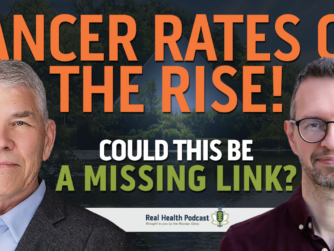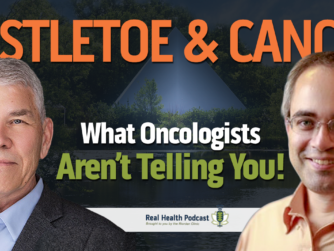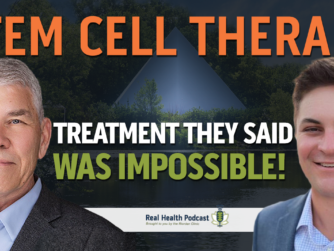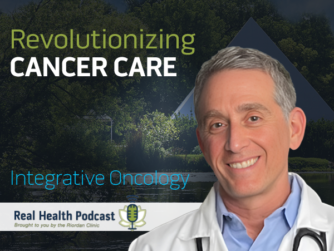This episode of the Real Health Podcast is a follow-up to an article published in the Riordan Clinic monthly newsletter called Health Hunters.
Dr. Dustin Moffit and Leah Chischilly talk about how building and maintaining muscle impacts overall health and why it is so important to stay physically active as we age.
Thank You to This Episode’s Sponsor
Episode Transcripts
Intro: This is the real health podcast brought to you by Riordan clinic. Our mission is to bring you the latest information and top experts in functional and integrative medicine. To help you make informed decisions on your path to real health. Welcome everybody.
Leah Chischilly: Welcome everybody to The Real Health Podcast. I’m your host today, Leah Chischilly and joining me from Hays. Kansas is Dr. Dustin Moffitt. Hi, Dr. Moffitt.
Dr. Dustin Moffitt: Hi, how are you?
Leah Chischilly: I’m good. How are you? Thank you for joining me today.
Dr. Dustin Moffitt: Thank you for having Me.
Leah Chischilly: I know it’s been a busy day for you, but we appreciate you taking the time out. Um, so today we’re actually going to talk about, we’re going to build on an article that you wrote and that article was titled Muscle as Medicine. And this is actually really interesting because I’ve never thought of muscle as medicine, it’s more just something that makes you stronger. So just in a nutshell, how does muscle become more than muscle and become medicine?
Dr. Dustin Moffitt: There is no simple nutshell other than if I’ve got to pin it down to something it’s a metabolic stabilizer. Um, so it helps our body’s entire metabolism balance itself a lot better. And then of course, medicine wise, it can also be protective to our, to the rest of our body. So that can, a lot of medicine nowadays is moving towards prevention. So, it really becomes a key integral part for preventative medicine.
Leah Chischilly: Yeah. And, you know, talking about aside from getting stronger, because that’s a pretty obvious benefit of it. But some of the things that you had talked about in the article, if you could just elaborate on a few of those, one thing you said is that it can potentially help with cognitive function. How does that work?
Dr. Dustin Moffitt: So the cognitive function piece can really come from something called, brain derived neurotrophic factor, which is just kind of a growth factor that helps our brain function a little bit better. But another way that it can work to help the brain function better is it stimulates human growth hormone. Human growth hormone is a preliminary to many of our other hormones. And when our hormones are balanced, our brain works a lot more functionally.
One of the key complaints of people aging is memory loss or fatigue, right? So when we stabilize those hormones, it stabilizes that, but also at a cellular level, it helps us balance our glucose and insulin metabolism. And when our blood sugars stay steadier, our brain works a heck of a lot better. Have you ever had a point where your blood sugar crashes and you just feel like you’re brain fogged you can’t think, all you can think about is food, right? That’s a survival mechanism. Um, so it’s there to help stabilize that.
Some other ways of how muscle as medicine works, is it makes our thyroid function a lot better when our thyroid functions better. Our underlying metabolism works better. Um, you have a better thermogenesis, let’s see some other ways of how to make brain work. I think, I think that kind of answers a good majority of it.
Leah Chischilly: Yeah. And I can definitely attest to that because a couple of years back when I was a patient here, um, found out that my hormones and my thyroid were out of whack. And in addition to taking supplements, something, I really made a conscious effort because I had been slacking for a number of years, was getting back into resistance training and building muscle. Also blood sugar imbalances. I had all these things. And so doing that I think was a huge benefit. And I know overall I feel so much better when I incorporate the weight training piece and am feeling strong.
Dr. Dustin Moffitt: Yeah. I noticed that myself. So that’s why I get into the gym and at least a couple of times a week lift heavy things to put them back down. Yeah.
Leah Chischilly: So I remember you saying that. I love it. It’s so simple. Right. Um, so another thing I want you to talk about, because this is a, a huge, very important thing is that building muscle increases mitochondrial synthesis, and I know our mitochondria are so important. So can you really simplify that for people? Because I think there’s a lot of people out there. We just don’t even know, what am I, what the mitochondria do?
Dr. Dustin Moffitt: The mitochondria are the easy thing to describe. Um, and Texas kind of went through that recently too, right? With power loss. Uh, mitochondria are the powerhouse of each of our cells. They help us regenerate energy and keep cellular functioning going, but they also help us utilize our oxygen. And through both of those is, um, basically how, how mitochondria work to improve, how our body works. And muscle stimulates, especially heavy weight training or HIIT training stimulate the mitochondrial enhancement, I guess. So it, it would help regulate something called mitochondrial dysfunction, which is yet again, not a technical diagnosis. It’s more of a symptom diagnosis.
Leah Chischilly: Now, mitochondrial dysfunction, is that just kind of a by-product of aging or are there other factors?
Dr. Dustin Moffitt: There are other factors, but primarily I would say aging would play a big role into it, but also environmental exposures. So if you are surrounded by toxic elements all the time, that’s gonna blunt our mitochondria. If you don’t fuel your body for success, by eating the right foods or getting an exercise routine in, that leads to poor mitochondrial function. Not sleeping well and can blunt that. So there’s a lot of different things that can affect how our mitochondria work. Um, there’s also fasting techniques that have been shown to increase mitochondrial function.
Leah Chischilly: Now, another question I want to ask you is in relation to diet, because I know that that’s so important for muscle building. What does kind of an ideal diet look for someone who’s trying to build more muscle or is there an ideal, is it something that’s individual?
Dr. Dustin Moffitt: It really is something individual. However, it has kind of been broken down into different body types. Um, so different body types will adapt better with maybe a higher protein or fat portion for muscle building. Um, some people actually need carbohydrates at a larger proportion. I’m not a big proponent of when you are trying to build muscle of a low carbohydrate diet that typically does not work. Um, carbohydrates replenish a lot of our muscular tissue, and can tend to build, especially if you’re going for more bulky type muscle, rather than a pure lean muscle. Um, it’s really that it’s hard to differentiate. Really that comes down to water weight is what it is, but, um, I like a very well balanced diet. So proportions can vary. For fat percentages, I’d say anywhere from 10 to 30% on average for different individuals. Carbohydrates can fluctuate between 30 and 60% on individuals. 60 is getting really high yet again, it’s going to be very individual, but most people would not do well with that amount. But that’s the beauty is that everybody is individual.
Leah Chischilly: Yeah. I think that’s really interesting and a great perspective because I think a lot of people believe that it has to be a low carb diet that if you want it and maybe, you know, if you want to get shredded or whatever.
Dr. Dustin Moffitt: And that, that is a low carb diet is essentially for, for reducing body fat percentage.
Leah Chischilly: Gotcha.
Dr. Dustin Moffitt: But it’s not always just about building muscle when you’re on that super low amount. Um, now you see a lot of people that are truly trying to build muscle that will do what’s considered a dirty bulk. Same thing. I’m more about a balanced lifestyle to, to keep things moving in the right direction.
Advertisement: There’s a lot more to this conversation and it’s coming up right after the break.
Today’s podcast is brought to you by LivOn labs makers of liposomal vitamins and supplements. LivOn uses liposomal encapsulation technology to protect nutrients from destruction in the digestive system. This allows for more efficient delivery of essential vitamins and nutrients. Choose from various supplements that support health and wellbeing such as lyposhperic vitamin C, magnesium, glutathione, and more. To learn more visit LivOn labs. That’s L I V O N labs.com.
Leah Chischilly: Now I know for a long time, people were all about cardio and cause a lot of people think about exercise just in terms of weight loss. And for a while, it was all about, cardio doing cardio. And now we’re looking at weight training and how that benefits with weight loss. Can you talk a little bit about that and why it’s so beneficial for people who are trying to lose weight to also do resistance training?
Dr. Dustin Moffitt: So, I mean, if you’re lifting at a consistent basis, especially if you write down your workout programs, there’s a lot of times if, if you’re lifting heavier weights, I don’t know about you, but my, my heart rate gets up to about 160, 180 beats per minute, just by lifting, um, specifically with like squats, lunges or deadlifts, um, it skyrockets pretty, pretty darn quick.
Leah Chischilly: Yeah. I think that was something that surprised me with weight training.
Dr. Dustin Moffitt: Yeah. Weight training can be a great source of cardio if you’re not just one of those people that sit around, not playing on their cell phone while on a bench in between.
Leah Chischilly: True.
Dr. Dustin Moffitt: Um, so if you get in there to actually do the work, a lot of the times you can get that cardio rate up, uh, cardio is very important. I don’t think there should ever be one thing or the other. I yet, again, I like a very well balanced. So to where maybe you do some weight training one day, uh, and the ideally trying to get heavyweight training. And this is something that I really have to push my female patients more. Um, it’s been instilled in them then, you know, anything small or bigger. I say, if your weights are colorful, it’s probably too light of a weight.
Leah Chischilly: Not true. They have some pretty heavy bumper plates that are colored,
Dr. Dustin Moffitt: I like seeing color. Anyway, I get distracted by colors easily,
Leah Chischilly: But dumbbells colored dumbbells, I think you’re right. That’s accurate.
Dr. Dustin Moffitt: Generally speaking, you know, push yourself when you go to pick up weights. Um, if, if you’re moving it around to light, um, and it’s easy, it’s not enough for muscle development. It’s enough for stability, but stability doesn’t go anywhere. So we always want to be trying to move forward.
Now. We also don’t want to push ourselves too hard, too fast, cause we don’t want to get injured and then lose traction and not be able to lift again.
Leah Chischilly: Yeah, now what about body weight exercises? Because I know a lot of us are not going to the gym right now and we’re working out at home. Are those still strength building as well?
Dr. Dustin Moffitt: They can be strength building. They’re not as challenging and they don’t build as much muscle. However, if you can learn to do calisthenics to where you actually use your muscles to counteract every single movement. So if you are doing like a modified bench press, if you can actually use your muscles to control back and forth motion, you can stimulate your body like it’s under a load. But if I were to just move my hands back and forth, that’s not enough. You really want to contract and then try to push through each portion. Um, and that’s where it can help at home exercises a lot more.
Or, you know, I tell people pickup Tide jugs or, you know, any kind of laundry detergent, five gallon buckets around here, uh, you know, almost every farm has it on there and you can load them up with lots of water or sand or grain. Um, you can, you can find ways to weight train at home as well.
Leah Chischilly: Yeah, absolutely. So someone who comes to you, they’ve never touched a weight in their life. They’re kind of intimidated by it. What’s some advice that you would give them to maybe get started with resistance training or building more muscle.
Dr. Dustin Moffitt: Find a darn good jam station.
Leah Chischilly: True, very true.
Dr. Dustin Moffitt: Reach out to somebody that you know, that that maybe could help you start with a partner or start with a trainer. Um, any anybody that has already been there. I’ve been doing the gym for a long time. So I get to see all kinds of people in their shapes, sizes, ages, ranges, sexes, everything. Um, I enjoy seeing everybody in there as long as you pick up after yourself and don’t sit on the bench forever
Leah Chischilly: Wipe everything down
Dr. Dustin Moffitt: Oh, that’s a different scenario. But you know, as long as you get in there and work, you’re doing the right thing. You’re doing better than, than somebody that’s sitting at home on the couch. Um, I don’t care what your experience level is. And you know, if somebody wants to come up to me and ask for guidance, I’m perfectly fine with that. I’ve been doing this a long time.
Leah Chischilly: Yeah. That’s great advice. I have another one question for you just based on a little bit, what you talked about in that article was a functional training. So what exactly is functional training and what are the benefits of that?
Dr. Dustin Moffitt: So functional training, I see as a way to move a weight or provide them movement of the body that would give us success in daily movements. So now that I’ve got my little one, she wants to run around and be held, but at the same point in time, she wants to wiggle, right? So we pick up, pick them up in very awkward positions. So same thing, you know, don’t be afraid to pick up a weight and move it in an awkward position that doesn’t feel necessarily comfortable to you, but it’s safe. We don’t want to hurt ourselves. Um, but I’ll do a lot of cross body motions. So where you start on one side of the body and you come across and go to the other, or, let’s see, what are some other ones? So when you do lunges doing like a cross lunge to where you’re not just lunging forward and lunging backwards, you’re actually mixing it up, going side to side, that’s more of a functional movement. When you do pull ups, instead of just going up and down, you can actually pull up and then side to side. Those are all functional movements. It’s making your muscles move outside of the plane of function that it normally would.
Leah Chischilly: Yeah. That’s got to be great for mobility in the later years, I would assume.
Dr. Dustin Moffitt: Yeah. Um, so being a great assessment of elderly, uh, on how likely they are to be injured or live a longer life has actually been shown the ability to actually squat down and get back up without the use of the hand.
Leah Chischilly: Interesting. I didn’t know that.
Dr. Dustin Moffitt: That came out probably eight, 10 years ago.
Leah Chischilly: Interesting. Well, we’ll have to look into that and see if we can link it in the show notes and see if we can find that one. So Dr. Moffitt, I have to ask you what, what’s your favorite type of strength training or what’s your PR
Dr. Dustin Moffitt: Favorite type of strength training? I just love heavy weights and I like free weights. I’m not a big weight machine type guy, depending on them. Uh, the gym, I may use some machines, but most of my weight, uh, revolves around, a squat rack, a bench press and in dumbbells,
Leah Chischilly: Keeping it simple
Dr. Dustin Moffitt: PRS, I don’t do those too much anymore, but I guess if for thrown out PRS, I think bench press the most I’ve ever done was 395. It was a competition to get to four plates. I didn’t quite make it. With squat the most I’ve ever done was I think 485 and dead lifts. I would say I think this one, I’m not sure of. I know it wasn’t a lot I’ve never been a, the best deadlifter. I think I got 425,
Leah Chischilly: not bad.
Dr. Dustin Moffitt: It’s been a long while since I’ve done those nowadays I stick mostly with about 275 to 300 on squats, um, bench press, usually about 225 to 275. Um, I’ve learned that as I age, it’s not quite worth pushing through the pain to, to meet objectives. Um, so yet again, I trained functionally to be strong, to balance, my metabolism and my mental health. So it’s all about the, the health aspect of lifting. Uh, yeah, I don’t go for true PR’s.
Leah Chischilly: I had to ask.
Leah Chischilly: No, that’s great. Well, I know that you’ve got to get back to seeing patients Dr. Moffitt, but thanks so much for joining me today. And I hope that everyone will now consider resistance training to help build more muscle so that it can act as medicine in your life. So thanks Dr. Moffitt,
Dr. Dustin Moffitt: You guys take care, take care.
Thank you for listening to the Real Health Podcast. If you enjoy this episode, be sure to subscribe and leave us a review. You can also find all of the episodes and show notes over at realhealthpodcast.org. Also be sure to visit Riordanclinic.org, where you will find hundreds of videos and articles to help you create your own version of real health.







